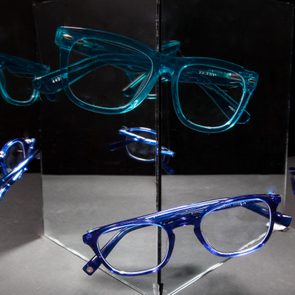Those tiny digits aren’t random. Knowing what the numbers on glasses mean will help you get the right fit and see better.

What the Numbers on Glasses Mean, According to an Optometrist

Hey, you with the glasses! Have you ever noticed those tiny numbers printed on the inside arm of your frames? If not, take a look. All glasses have them. What do the numbers on glasses mean? It’s a question we’ve asked ourselves many times—Reader’s Digest editors are nothing if not bespectacled.
It turns out it has nothing to do with your eyesight. Whether you wear distance glasses, reading glasses, polarized sunglasses or even blue light glasses, your eyewear is more than just a prescription, and these little numbers have a major role to play.
Reader’s Digest spoke to Jonathan Wolfe, DO, an optometrist and founder of Ardsley Eyewear in Ardsley, New York, to break down these tiny numbers. So what do the numbers on glasses mean? You’re about to find out.
Get Reader’s Digest’s Read Up newsletter for more knowledge, humor, travel, tech and fun facts all week long.

What do the numbers on your glasses mean?
A lot, as it turns out. “On a typical pair of glasses, you’re going to find three measurement numbers, usually in the form of AA-BB-CCC,” Dr. Wolfe says, emphasizing that he is using letters here to clearly represent the numbering format (you won’t see those actual letters on your glasses).
These numbers, aka eyeglass frame measurements, are how optometrists and opticians determine the size and fit of your glasses. Without these numbers, we would all be walking around with glasses that are too big or too small for our faces.
Here’s what each section of the frame measurement means:
- Lens width (AA): Also called “eye size,” this number describes the width of each lens horizontally. It does not include the frame; it is a measurement of the clear lens at its widest point, from one side to the other. A typical measurement is between 40 and 60 millimeters (mm).
- Bridge width (BB): The second number, the bridge width, measures the shortest distance between your two lenses. The bridge of your glasses is the part that sits on your nose, and this measurement is usually between 14 and 24 mm.
- Temple length (CCC): This longest measurement (typically 120 to 150 mm) describes the length of the “temple” (aka arm) and tracks from the screw on your glasses to the end of the temple behind your ear. This number will usually be in increments of 5 mm.
Why is this important to know?
You want your glasses to fit properly, right? “A common misconception among patients is that their eye size is fixed, and that if the eye size of their current glasses is, say, 54 (and they like how they look), then they need their new glasses to be a 54 as well,” Dr. Wolfe says. That’s not necessarily the case because the AA and BB values interact depending on the individual design, size and frame style.
“For example, you may have a very rectangular frame with an eye size of 56 and a 16-mm distance between lenses,” Dr. Wolfe says. “If you wanted to switch to a rounder look, you may get a similar fit with a frame that has an eye size of 50 but an 18-mm distance between the lenses.”
If you assume your current fit will translate to a totally new style—nope!—your glasses won’t fit your face. “This is why it’s important to try frames on in person, rather than simply going by the eye size number of your current glasses,” he adds.
Not to mention, everyone’s face is shaped differently, which means a pair of glasses that fits one person perfectly might not suit someone else. Knowing a few basic facial measurements can make it easier to find frames that fit comfortably and securely.
How to read prescription numbers
A good fit and a fashionable style aren’t the most important part of choosing glasses, of course. You also want to see! If you’ve ever tried to order glasses online or pick up new specs at a discount glasses store, you know you need to have your prescription handy. Unfortunately, these numbers can be super confusing. Now that you know what the numbers on glasses mean, let’s get to the bottom of how to read an eye prescription too.
Here are the main numbers that you will see on your eyeglass prescription, according to the American Academy of Ophthalmology. These numbers are usually laid out in a chart form, and each eye has its own line:
- O.D. and O.S.: This label on the left-hand side tells you which eye the rest of the prescription is talking about. O.D. means oculus dexter and refers to your right eye, while O.S. means oculus sinister, and yep, that’s your left.
- Sphere (SPH): This number corrects for nearsightedness and farsightedness. A minus sign (-) means you need help seeing far away, while a plus sign (+) means your glasses help you see up close.
- Cylinder (CYL): If you have a number here, you have astigmatism that needs correcting. In other words, your eye is not a perfect sphere.
- Axis: This tells your eye professional where on the cornea your astigmatism is located. This number is written in degrees, from 1 to 180.
- Add: This is the additional lens power, which is used in bifocals. If you need extra help reading, the “add” refers to the extra lens power in the bottom part of your glasses.
Common mistakes when reading your glasses numbers
Glasses that don’t fit will tire your eyes, give you headaches and keep you from seeing your best. Avoid these common mistakes when buying glasses:
- Buying the same size glasses without trying them on. Wolfe says conflating sizes from style to style could leave you with ill-fitting glasses. For example, you could see a drastic difference in fit between a 50-20-140 frame and a 54-18-145 one.
- Mixing up lens width and frame size. Lens width (aka eye size) is not the width of the whole frame, just one lens.
- Ignoring pupillary distance. This is the distance between your eyes, which an optical professional measures when sizing your glasses. Misalignment will tire your eyes, so again, make sure you get a good fit.
- Using outdated prescriptions. Your vision changes with time, so make sure you get your eyes checked periodically before reordering the same old glasses. Most pros recommend every two years, but ask your doctor to make sure.
About the expert
|
Why trust us
At Reader’s Digest, we’re committed to producing high-quality content by writers with expertise and experience in their field in consultation with relevant, qualified experts. We rely on reputable primary sources, including government and professional organizations and academic institutions as well as our writers’ personal experiences where appropriate. We verify all facts and data, back them with credible sourcing and revisit them over time to ensure they remain accurate and up to date. Read more about our team, our contributors and our editorial policies.
Sources:
- Jonathan Wolfe, founder of Ardsley Eye Care in Ardsley, New York; interviewed, 2023
- American Academy of Ophthalmology: “How to Read an Eyeglasses Prescription”
- Warby Parker: “Glasses Measurements: How To Find Your Frame Size”























